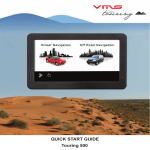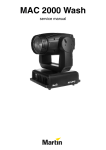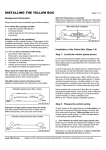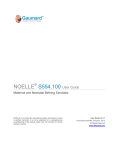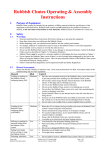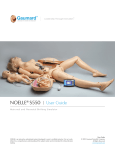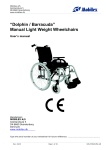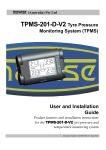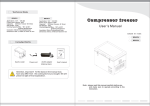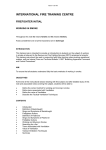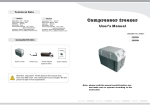Download User Guide
Transcript
Vehicle Recovery Device ‘BOG OUT’ is a lightweight, compact and economical device that can be used with simple instruction to assist in removing vehicles from bogs… BY USING THE VEHICLES OWN WHEELS AND TYRES AS WINCHES. ‘BOG OUT’ can be used to get the vehicle out, either forward or backward, with just one person. ‘To solve the problem is simple. Get traction and drive out’ Welcome to the ‘BOG OUT’ solution and congratulations on your purchase. Contents One ‘BOG OUT’ recovery device Two red connector ties One carry/storage backpack Instruction/warranty/contact/order manual Vehicles get stuck in various situations because they lose traction on one or more of their tyres. Differentials (diffs) drive the front and/or rear pairs of tyres and transfer power to the tyre that has the least amount of load, or traction. Diffs are designed that way. 4wds are called that because they can drive from any of their 4 wheels, but usually only 2 at once, one on the front and one on the rear, and only those with the least load. On a 2 wheel drive, loose traction on one of the driving tyres and you’re stuck. 4wds are better, but loose traction on a front and a rear tyre and the result will be the same. You’ll be stuck. Getting unstuck is something most 4wd users have some experience at. It’s almost always a messy, difficult and time consuming affair and can also be dangerous, and sometimes expensive. Staying bogged is not much fun and getting out is the priority, especially on isolated tracks where assistance may not be available for days or even months, or where flood or tide might present a danger. ‘BOG OUT’ employs a simple principle, essentially it is a harness designed to capture the winching or rotational power of a driven wheel. There are two methods of attaching a ‘BOG OUT’ to your tyre and you should decide which suits your vehicle before you need it. Red connector ties Safety Tips. Read before installing or attempting recovery Read full Instruction Manual first and comply with directions Make area safe from other vehicle traffic Ensure vehicle is stable and can’t move (eg roll, slide, tip, fall) Turn motor off and make sure it can’t be started Beware of sharp or hot parts about the vehicle esp brakes Choose anchor suitable for the job and in line with wheel Always use dampener in case of breakage and recoil Remove onlookers to safe distance away from recovery area Engage BOG OUT in a SLOW AND GENTLE manner Ensure the BOG OUT is continuously fitting over the wheel correctly Do not approach any recovery equipment under tension Immobilise vehicle before removing BOG OUT Quick User Guide Refer to full Instruction before use Method ‘one’ can be used on the wheels of all vehicles that have adequate clearance between the wheel and the brake, steering and any other mechanical parts of the vehicle. If there is any doubt, use method ‘two’ or consult a mechanic. Method one Connect through rim Method two Form a snare Read safety tips first Read safety tips first Lay BOG OUT along ground and attach ‘short tails’ end to selected wheel by passing one red connector tie through rim and tying firmly using sheet bend knots. Be certain wheel can rotate freely without BOG OUT catching on steering or brake parts. Align BOG OUT in line with wheel and towards the direction you want the vehicle to move (front wheel for forward and rear wheel for reverse). Attach other end of BOG OUT to a suitable anchor point Lay BOG OUT along ground and attach ‘long tails’ end around selected wheel by passing BOG OUT over the tyre and returning the long tails along the ground back to the device. Tie each of the tails to the BOG OUT to form a snare using two red connector ties. Align BOG OUT in line with wheel and towards the direction you want the vehicle to move (front wheel for forward and rear wheel for reverse). Attach other end of BOG OUT to a suitable anchor point Method of Use 1 in more detail IMPORTANT make sure the vehicle is turned off and can’t be started or moved whilst engaging the ‘BOGOUT’ Simply lay out a ‘BOG OUT’ in line with the tyre that has lost traction (rear tyre for reverse and front tyre for forward recovery) and attach the short tails end to the wheel by passing the red connector tie (supplied) through the rim and attaching to the spliced eyes of the ‘BOG OUT’. Tighten the red connector tie firmly to the ‘BOG OUT’ so the first rung and the red connector tie grip the tyre snugly. ‘BOG OUT’ Method 1 can be used on most wheel types and vehicles provided brake and or steering parts are not likely to become entangled or disturbed. If there is any risk of that, use Method 2 The preferred knot is shown below and is known as a ‘sheet bend’. After use, this knot can be loosened when worked and the strap can be reused if it hasn’t been damaged. If it has pulled too tight, then cut the strap away when finished and discard it (take care to not damage the ‘BOG OUT’). These ties are cheap to replace and should be considered disposable. Most vehicles are able to have the ‘BOG OUT’ connected through the wheel this way but not all. Some have brake parts etc in the way inside the rim, and would foul with the red connector tie etc when rotated. Before using a ‘BOG OUT’ this way you should check to make sure your vehicle has adequate clearance for the recovery device to function. Ask a mechanic if you’re uncertain. It is recommended that no shackles or other mechanical devices be used on the ‘BOG OUT’ because of potential damage to the tyre or other parts of the vehicle and also because of the possibility of creating a dangerous missile if a part of the recovery equipment fails under load. Once the ‘BOG OUT’ is attached to the desired wheel, you’ll need to attach the other end to an anchor point. This may be a tree or large rock etc if these are stable. Common sense should prevail as it would be folly and dangerous to pull a tree over or dislodge a boulder on a slope. Falling branches from trees being utilised in the recovery process can also pose a risk. TAKE CARE and never allow people to push the vehicle whilst recovery is in progress Other anchors are available including typical ‘digging’ anchors or by digging a hole for a suitably strong and large item such as a spare wheel or log. Any recovery equipment used in conjunction with the ‘BOG OUT’ should be of adequate rating and condition. It’s best to keep the ‘BOG OUT’ on the ground if possible and attach a dampener in case of breakage and recoil. The ‘BOG OUT’ device should be in line with the track of the wheel it’s attached to and in the direction the recovery will proceed. Tie the ‘BOG OUT’ firmly to the anchor system preferably using the same ‘sheet bend’ knot. Avoid shackles. Guy ropes may be necessary to keep the recovery and device in line. Safety should be the prime concern and all persons should be kept well away from potential harm. Another factor to consider is the potential to destabilise a vehicle during recovery. The ‘BOG OUT’ is made from exceptionally strong materials and is more that capable of pulling a vehicle over if used unwisely. Only ever attempt to recover a vehicle if it is in a level situation and able to be recovered in a straight and level line. Call for expert assistance if in any doubt. Once all is attached, the recovery can proceed. When all persons are clear, start the motor and select the gear required. Use low range and first or reverse gear. SLOWLY take up the tension by judicious use of the clutch and accelerator. When the vehicle moves, stop and check everything is safe and secure and that the ‘BOG OUT’ is forming correctly and evenly as a harness for the tyre. Under NO CIRCUMSTANCES should anyone get under the vehicle or near the recovery gear whilst it is under tension, or in any position where they may be harmed. Remember, vehicles in slippery situations may slide or move unexpectedly. KEEP SAFE! ‘BOG OUT’ is designed to allow a vehicle to ‘creep’ or ‘inch’ its way out of a bog. It has little stretch and is NOT designed to accept shock load like a snatch strap. It is an extremely strong device, and will likely damage the vehicle or itself if used in any way other than slowly and carefully. Once the vehicle is successfully removed from the bog, the ‘BOG OUT’ can be easily removed by reversing direction or by ‘rocking’ the vehicle slightly forward and back, pulling the device off the wheel sideways if it is safe to do so. A carry bag is supplied to store the device until it can be cleaned and dried and repacked for future use. Method of Use 2 in more detail IMPORTANT make sure the vehicle is turned off and can’t be started or moved whilst engaging the ‘BOGOUT’ If your vehicle has brake or steering parts in the way, then no problem, there is another way to utilise your ‘BOG OUT’. Lay out the ‘BOG OUT’ in line with the tyre that has lost traction in the direction the recovery is to proceed (rear tyre for reverse and front tyre for forward motion). Lift the long tails over the tyre and around it and pull the long tails with the spliced eyes down to the ground until the first ‘rung’ is on the ground. The long tails then need to pass along the ground and back to the main straps of the ‘BOG OUT’. Some mud, sand or dirt may have to be scooped out of the way first. The eyes can then be tied to the main straps thereby ‘capturing’ the tyre in the harness. The spliced eyes should be connected using the red connector ties (supplied) so the harness can ‘noose’ and grip the tyre as in the following diagrams. Note position of rung. Lay long tails of ‘BOG OUT’ over tyre Pull long tails along ground and back to straps ‘BOG OUT’ can tighten Connect firmly using two red connector ties above rung as shown ‘BOG OUT’ cannot tighten It is important to have at least five rungs on the tyre. This keeps the ‘BOG OUT’ away from the brake and steering parts of the vehicle. Position the red connector ties so that they can slide and tighten. This will allow the ‘BOG OUT’ to snare the tyre. When the tyres shown above are driven clockwise, ‘BOG OUT’ will tighten against the anchor and provide positive traction. The same ‘sheet bend’ knot is preferred. Length of the red loop can be adjusted to suit different tyre diameters It is recommended that no shackles or other mechanical devices be used on the ‘BOG OUT’ because of potential damage to the tyre or other parts of the vehicle and also because of the possibility of creating a dangerous missile if a part of the recovery equipment fails and creates recoil. Once the ‘BOG OUT’ is attached to the desired wheel, you’ll need to attach the other end to an anchor point. This may be a tree or large rock etc if these are stable. Common sense should prevail as it would be folly and dangerous to pull a tree over or dislodge a boulder on a slope. Falling branches from trees being utilised in the recovery process can also pose a risk. TAKE CARE and never allow people to push the vehicle whilst recovery is in progress Other anchors are available including typical ‘digging’ anchors or by digging a hole for a suitably strong and large item such as a spare wheel or log. Any recovery equipment used in conjunction with the ‘BOG OUT’ should be of adequate rating and condition. It’s best to keep the ‘BOG OUT’ on the ground if possible and attach a dampener in case of breakage and recoil. The ‘BOG OUT’ device should be in line with the track of the wheel it’s attached to and in the direction the recovery will proceed. Tie the ‘BOG OUT’ firmly to the anchor system preferably using the same ‘sheet bend’ knot. Avoid shackles. Guy ropes may be necessary to keep the recovery and device in line. Safety should be the prime concern and all persons should be kept well away from potential harm. Another factor to consider is the potential to destabilise a vehicle during recovery. The ‘BOG OUT’ is made from exceptionally strong materials and is more that capable of pulling a vehicle over if used unwisely. Only ever attempt to recover a vehicle if it is in a level and stable situation and able to be recovered in a straight clear line. Call for expert assistance if in any doubt. Once all is attached, the recovery can proceed. When all persons are sufficiently clear, start the motor and select the gear required. Use low range and first or reverse gear. SLOWLY take up the tension by judicious use of the clutch and accelerator. When the vehicle moves, stop and check everything is safe and secure and that the ‘BOG OUT’ is forming correctly and evenly as a harness for the tyre. Under NO CIRCUMSTANCES should anyone get under the vehicle or near the recovery gear whilst it is under tension, or in any position where they may be harmed. Remember, vehicles in slippery situations may slide or move unexpectedly. KEEP SAFE! ‘BOG OUT’ is designed to allow a vehicle to ‘creep’ or ‘inch’ its way out of a bog. It has little stretch and is NOT designed to accept shock load like a snatch strap. It is an extremely strong device, and will likely damage the vehicle or itself if used in any way other than slowly and carefully. Once the vehicle is successfully removed from the bog, the ‘BOG OUT’ can be easily removed by reversing direction or by ‘rocking’ the vehicle slightly forward and back, pulling the device off the wheel sideways if it is safe to do so. A carry bag is supplied to store the device until it can be cleaned and dried and repacked for future use. General The ‘BOGOUT’ standard model is designed to fit all common 4wd tyre sizes, small tractor and most cars. Tread patterns from 165mm (6 ½”) to 315mm (12 ½”), and wheel diameters of 13” and larger are accommodated. For smaller or larger tyres and wheels (including small car or larger tractor) see ‘BOGOUT’ website where online ordering is available for various other standard or customised solutions. We can make these to almost any specification ie length, width, strength, material or even colour. The ‘BOG OUT’ must be kept in line with the line of the tyre it’s attached to. If the bog area is small this is not so important, but if the ‘BOG OUT’ is to be engaged for more distance, it must fit neatly over the tyre, and therefore it would need to be kept straight. More than one ‘BOG OUT’ device can be employed end on end to help vehicles move longer distances, but care MUST be taken so that the device doesn’t foul on any mechanical parts of the vehicle as the ‘BOG OUT’ becomes progressively wound onto the tyre. It is also possible to ‘double up’ a ‘BOG OUT’ if extra strength is thought to be needed. Caution always must be taken and you will need to stop the recovery if there is a possibility of ‘BOG OUT’ disturbing brake or steering parts especially hydraulic brake lines. IF IN DOUBT, DON’T USE THE DEVICE. If the ‘BOGOUT’ is correctly used, the vehicle should drive out of the bog with ease. If not, the vehicle may be snagged or otherwise restrained and you’ll have to clear that before reattempting the procedure. Guy ropes might be considered to assist keeping the ‘BOG OUT’ in line with the tyre if the vehicle moves off line, or retie/relocate the anchor. Again keep people well away from the recovery area. It’s unlikely that the ‘BOG OUT’ could be broken by the vehicle if used correctly because the device is designed to be stronger than the weakest part of the drive train ie the vehicles clutch. BUT if the ‘BOG OUT’ is damaged, typically by sharp rocks, tree roots or misuse etc, it should be discarded and replaced. It must be understood that the device would likely be used in hostile circumstances, therefore care and common sense MUST be employed. Whilst we have used the same device in many recoveries, it only takes one cut to render the ‘BOG OUT’ device unserviceable. Removing the ‘BOGOUT’ from a wheel and storage To remove the device, simply reverse the direction until it’s unwound off the tyre, then undo the red connector/s. Another way is to ‘rock’ the vehicle forward and reverse taking a wrap off sideways each time. Store in the carry bag provided and wash in clean fresh and warm water if necessary when convenient. Dry in the shade and repack for further use. The red connector tie is sacrificial and should be replaced when damaged. These are available on our website www.bogout.com or enquire in store where ‘BOGOUT’ is sold. Anchoring Systems Finding a suitable anchor to secure the ‘BOGOUT’ might be as simple as attaching it to a conveniently placed tree, or another vehicle. Always use a tree protector strap, especially as trees near boggy sites are valuable not only to you but others as well for future recoveries. There are many other methods that can be utilised and there are various anchors available on the market, some designed for boats and some for 4wd’s. Also there are many other solutions demonstrated on the internet. ‘BOGOUT’ has designed one specifically that may be better suited to the job and is available via the website www.bogout.com or enquire in store where ‘BOGOUT’ is sold. Learning to use ‘BOG OUT’ is not difficult but easiest in a clean, not-bogged situation. Learn the simple knots and methods before you get into a situation and when the time comes to get a vehicle out of a real bog, it will be all the more easy and safe. If you’re really stuck and have lost traction to both wheels (front or back), you might need two ‘BOG OUT’ devices. This offers a potential traction capability of a massive eight tonnes, or four times the capacity of most clutches. USE AS A TOW ROPE The ‘BOG OUT’ can also be used as a tow rope. Simply roll the main straps together to tidy the rungs and use like any other tow rope. The ‘BOG OUT’ 4x4 model is made from two main straps each with a break strength of about two tonnes, so the device can pull up to about four tonnes of load. Never use tow bar tow balls as points of attachment and always use a dampener in case of equipment failure and recoil. Different countries and states etc have different regulations regarding the use of tow ropes and you should comply with those regulations. Also tow ropes wear from being in contact with the road and would weaken/damage your ‘BOG OUT’ so this must be considered. USE AS A LIFTING/RESTRAINING DEVICE ‘BOG OUT’ is not designed for lifting and has not been tested or rated for such. Under no circumstances should the ‘BOG OUT’ be used in this manner. ‘BOG OUT’ by way of its ‘ladder’ design may come in handy to assist in securing light loads. However common sense must be employed, the device is not specifically designed for such work and has not been tested or rated for such. CUSTOM MADE DEVICES ‘BOG OUT’ can be custom manufactured to your specifications. We have standard models in stock and these may suit your purpose, so check our website www.bogout.com We advise that you discuss specific requirements with our technical staff as the system may appear simple, but considerable research and development has gone into it, and it’s easy to make mistakes and/or incorrect assumptions. Our staff will be happy to assist you to design the best solution for your particular needs. SAFETY It should go without saying that vehicle recovery can be dangerous. Many people have been injured or killed during vehicle recovery operations. Excessive loads can be applied to recovery gear which can break or cause damage to the vehicle and vehicles can move suddenly and unexpectedly. Always keep people sufficiently well back from the recovery area Always go slowly and steadily and continually check equipment is functioning correctly Beware of anchor points that have recovery gear under tension attached Keep recovery gear on or close to the ground and utilise recoil dampeners Resist using shackles or other mechanical devices Don’t use tow balls on tow bars as attachment points Discard damaged or worn equipment WARRANTY It must be understood that the ‘BOG OUT’ device would likely be used in circumstances hostile to its components ie rope, webbing and stitching, therefore care and common sense MUST be employed. The manufacturer cannot be held responsible for damage done to the device during recovery situations. The manufacturer warrants however that care has been taken to provide the device free from defects. In the unlikely event that the product is manufactured defectively the manufacturer will replace the item for free, excluding postage, for a period of 12 months from the date of purchase. Simply contact our office +61 418772751 with proof of the purchase date and location and details of the defect for discussion or return the device with proof of purchase and contact details to ‘BOG OUT’ PO BOX 13 Cairns, 4870, Queensland Australia.









